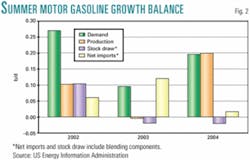US retail gasoline prices are expected to average $1.76/gal during April-September, about 20¢ higher than for the same period last year, according to US Energy Information Administration projections released Apr. 8.
The projection falls far short of the March 1981 all-time high of $2.99/gal, adjusted for inflation and expressed in 2004 dollars.
"Gasoline markets are tight as the 2004 driving season begins, and conditions are likely to remain volatile through the summer. High crude oil costs, strong gasoline demand growth, low gasoline inventories, uncertainty about the availability of gasoline imports, high transportation costs, and changes in gasoline specifications have added to current and expected gasoline costs and pump prices," EIA said.
US motor gasoline demand is projected to average 9.32 million b/d, a new high that is above the average of the previous 5 years despite high prices.
For the summer of 2003, US motor gasoline demand was 9.12 million b/d.
EIA said demand continues to rise annually because the number of drivers and vehicles is rising along with the general population. Average fuel efficiency is virtually changed from last year.
"Relatively tight inventory levels are expected to keep pressure on refinery output and import sources during peak demand periods," EIA said.
Escalation causes
The combined impact of high crude oil prices, continuing growth in demand, low inventories, and the ongoing transition from methyl tertiary butyl ether (MTBE) to ethanol in several regions are projected to contributed to high average motor gasoline prices for this driving season," EIA said.
Some months could see average prices at or above $1.80/gal. West Texas Intermediate (WTI) benchmark prices briefly surpassed $38/bbl in late March, the highest level since early 1991. WTI prices are projected to average $33.40/bbl for the summer, EIA said.
Factors contributing to recent and projected high crude oil prices include the Organization of Petroleum Exporting Countries' determination to limit oil output, uncertainties surrounding the continued recovery of output and exports from Iraq, and political unrest in Venezuela.
Factors affecting US retail gasoline prices include expectations of low motor gasoline stock levels for much of the summer as well as maintaining a need for high levels of domestic production and imports to meet demand.
Other factors affecting gasoline prices include additional transportation and blending costs related to the substitution of ethanol for MTBE in certain markets and the reduction in permissible sulfur content mandated by the US Environmental Protection Agency.
MTBE
"Gasoline markets in the US have entered a period of uncertainty because of bans on the blending of MTBE into gasoline in California, Connecticut, and New York that took effect on Jan. 1," EIA said.
Fuel ethanol is used to replace MTBE in the production of reformulated gasoline. Fuel ethanol production has increased to 211,000 b/d in January 2004 from 177,000 b/d in January 2003. MTBE production has fallen during the same period to 107,000 b/d from 170,000 b/d, EIA said.
Based on EIA's weekly gasoline price survey, regular gasoline averaged $1.74/gal in March, 4¢ higher than a year ago and 26¢ above the 14-month low of $1.48/gal in December 2003.
"On a monthly average per-gallon basis, crude oil costs rose about 11¢ from December to March. Thus margins (the difference between pump prices and crude oil costs) rose 15¢/gal over the 3-month period," EIA said. "Such an increase for December to March is similar to one seen in 1999-2000. However, the increase is actually much less than the 22¢ seen in 2002-03. In those previous instances, margins continued to climb in April, and this is expected to be the case again this year, as marginal production and acquisition costs for gasoline continue to rise. For the summer, overall margins this year are expected to be comparable to those in 2001."


